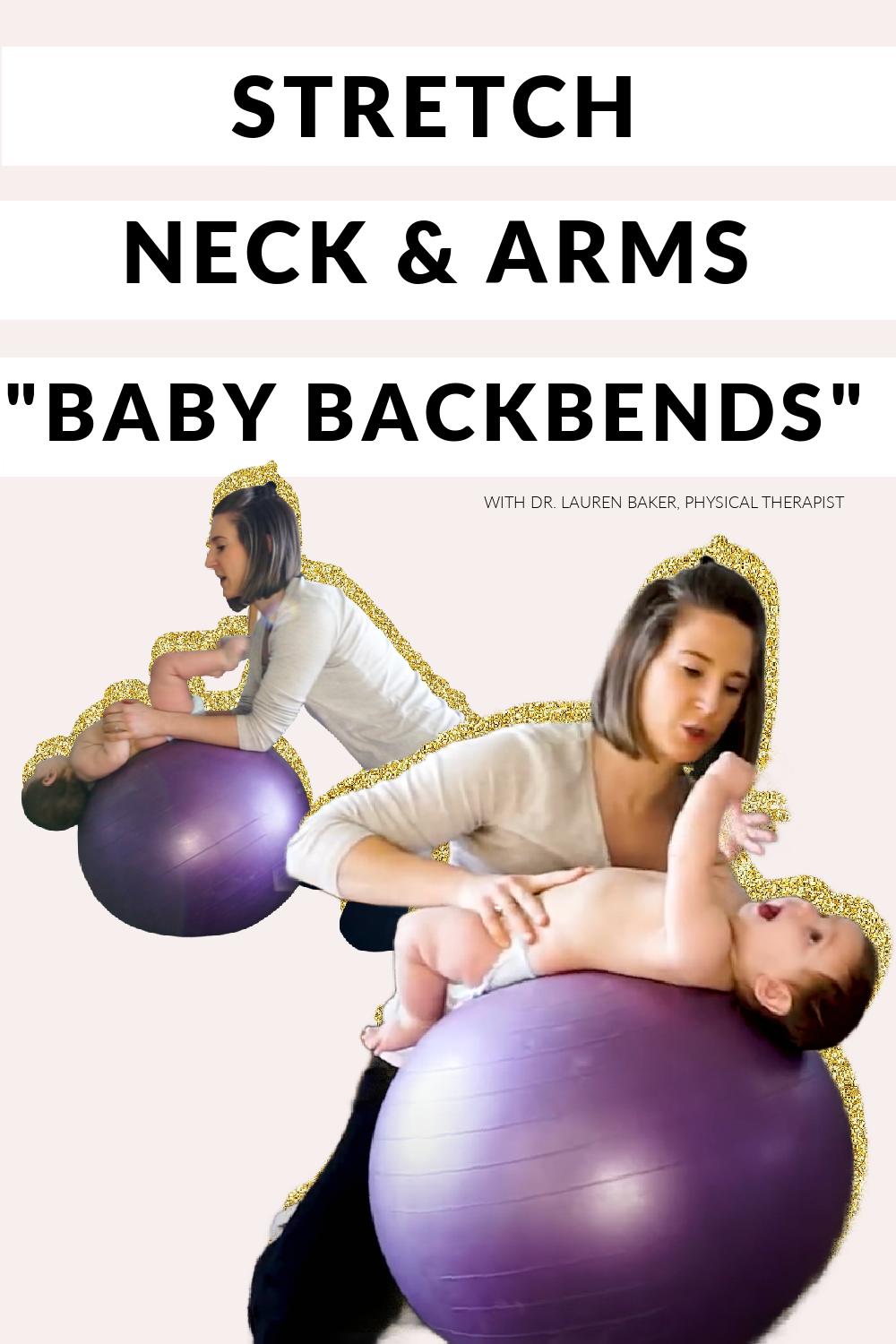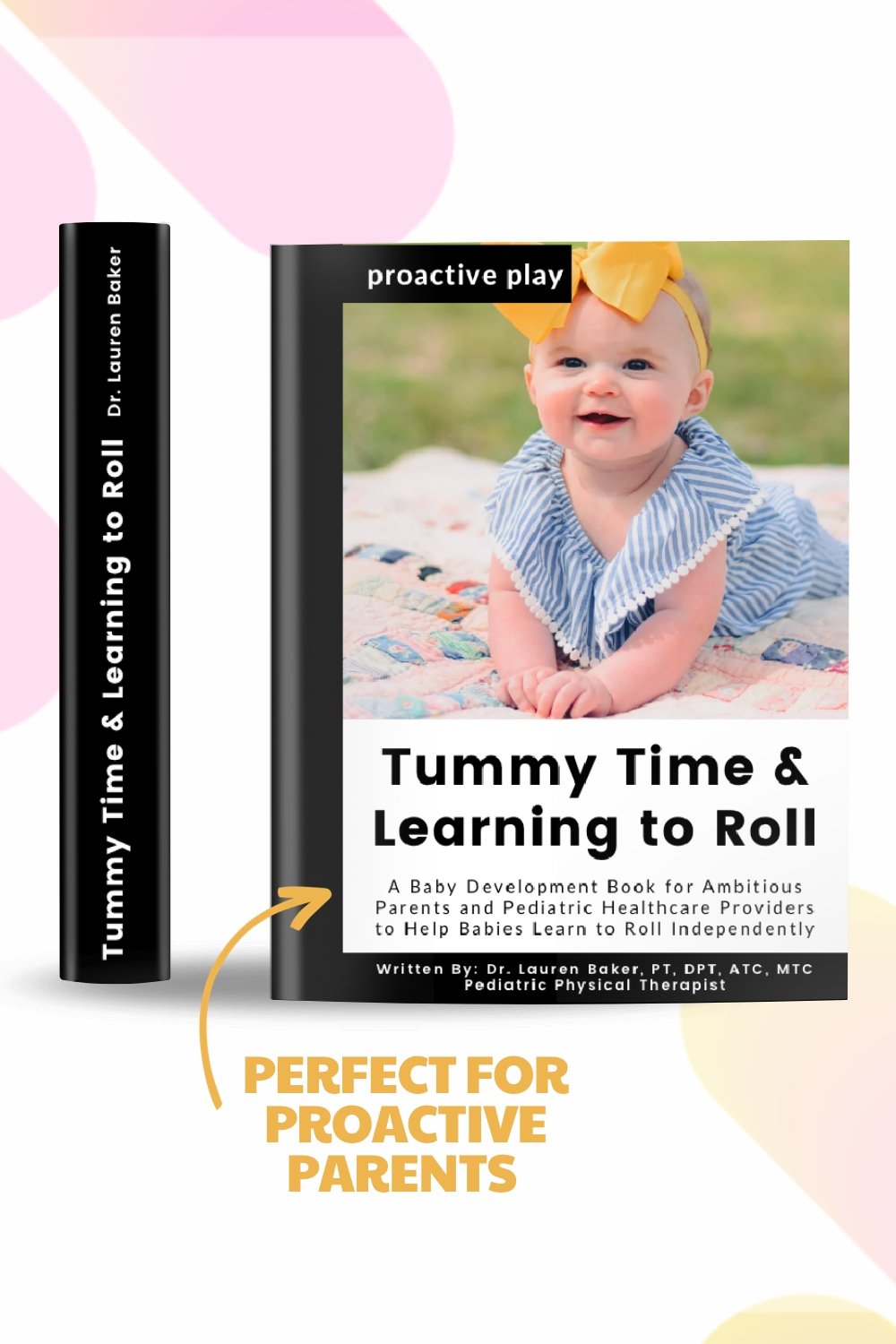How To Stretch A Baby’s Neck and Arm Muscles With Baby Backbends
this blog contains affiliate links
Hello, proactive parents! I'm Dr. Lauren Baker, a pediatric physical therapist with a passion for helping active parents and their little ones move better. Today, I’m super excited to share with you a playful and effective exercise to stretch your baby’s abdomen, neck, and arms.
This routine is not just fun but crucial for developing flexibility, supporting milestones like rolling, sitting, crawling, walking, and addressing conditions like torticollis. Our goal is to make movement a magical experience, for both parents and babies.
As a bonus, this exercise also incorporates the vestibular system, an important sensory system that helps your baby begin to understand where they are in space and help them balance.
Stretching the Neck, Arms, and Belly: Baby Backbends on a Stability Ball
This exercise is often a baby favorite, don’t be surprised if you find them giggling and loving this exercise because it is new and novel.
This exercise uses a stability or exercise ball to help your baby ensure they have the flexibility they need in the front part of their body. Often babies can have tightness in the front of their necks, sides of their trunks/under their arms, and the front of their bellies.
The stability ball provides a gentle and supported way to help babies relax in this position, while incorporated gentle backward/forward motion in order to help facilitate the stretches.
How to Do It
for the best and most comprehensive information, make sure to watch the youtube video down below
Type of Ball: The first thing you’re going to need for this exercise is a stability ball or exercise ball. Often families have one in the home already, but if not one can be purchased off amazon, at target, or walmart, second hand or even borrowed from a family member or friend.
The best size is between 45-65 centimeters and can depend on the size of the baby. Babies that are small and 3-4 months I often recommend small stability balls closer to 45cm but most babies do well on a 55cm stability ball.
Sometimes, 65cm balls can be tough for smaller parents get close to their baby, so I don’t often recommend that big of a ball, but if that is what you have at home, just deflate it a little bit so it isn’t too tall.
When you are on your knees, you want to be able to have your baby lying back on the ball at approximately your hip/lower chest level. You want to make sure you can comfortably bring your chest over the top of the ball to bring them back into a supported sitting or held position.
Position: Keep your body close to your baby and gently lay your baby on their back on the top of the stability ball, with their feet near your body, face up, and the top of their head pointing away from you.
Support: Place your hands securely on their pelvis, I prefer to keep both hands on the top of the pelvis, you want to make sure the baby’s legs lay straight and don’t curl up toward their bellies. You want the baby to be in a gentle backbend.
Action: Gently roll the ball forward and backward, allowing your baby’s head to relax and stretch out the belly. The baby’s neck should be open with their head resting on the ball.
Benefits: This movement stretches the abdomen, neck, and arm muscles and provides vestibular input, which is calming and helps with sensory integration.
TIMESTAMPS:
0:50 stretch for babys neck and belly exercise #1 backbends on stability ball
1:21 stretch for babys neck exercise #2 both hands down backbends on stability ball
2:25 using bounces to calm baby down and increase vestibular regulation
3:07 stretch for babys neck exercise #3 one arm down backbends on stability ball
6:03 how to use exercises to a baby's tolerance
45-75cm stability balls [multiple colors and all sizes]
TOY IDEAS:
Best Toys for Babies Learning to Roll
Best Toys for Babies
PT Approved Equipment/Containers for Babies
Tummy Time Toys
There are two options for where the arms go:
Arms at the sides to emphasize stretching the neck
Arms above the head to emphasize stretching the neck and arms
If a child has a history of torticollis, sometimes holding the arms at the sides will assist in focusing on the neck, but the truth is that sometimes it feels harder to hold the child in the right position when holding their arms down.
These days, I personally prefer allowing the child’s arms to be free, ideally overhead. A lot of children have tightness in the front of their chest and when they are lying backwards over the stability ball, their upper trunks are in extension, this makes bringing their hands overhead even hards, putting more of a stretch on the sides of their trunk.
To help encourage the relaxation of these muscles, I love when another family member or sibling is standing or kneeling by the baby’s head and gently touches the arms encouraging them to go straight.
You do not want to push the baby’s arms toward the ball, you only want to gently stroke the childs arms or tickle the arms or try to get them to reach for your hands. The goal is for the baby to relax their arms overhead over time, not the first time.
Tips for Helping Babies Relax & Stretch Their Arms & Necks
Gentle Guidance: Use your hand to gently guide the top of their chest and stretch the fascia.
Come Up With Ease:
2-5 months: To help your baby come up, bring your chest close to their body and bring your arms behind the baby to support their body and head. Bring them to your chest and lift off the ball.
6 months+: To help your baby come up, gently roll them to the side and encourage pushing up with their arm, going into a sit to sidelying to sit “sit up,” fostering a mix of strength and flexibility.
Use Bounces: Between repetitions, if your baby has head control, you can bring them into sitting and gently bounce on the ball. This can be soothing and is great for vestibular input.
How Many Times or How Long? Babies do really well with this exercise when completing 10-30 times or for 2-5 minutes total (with seated or holding breaks).
If a baby struggles with this exercise, it might be due to tightness in the front of their neck or chest. This is still a great exercise for babies with tightness in those areas to do, but parents may need to go slower to their specific baby’s tolerance.
If a baby only tolerates 5 forward/backward motions, then stop there and build 1-2 more if tolerated. It may take a few days or week to slowly build up to 10-30x.
Making It a Soothing Routine
These activities are perfect for winding down and getting ready for bed. The combination of stretching and vestibular input from bouncing can be incredibly soothing for your baby, making this routine a fantastic prelude to nighttime calmness.
This obviously should not be done before bedtime, if a baby struggles with this exercise, doing it during wake periods would be more appropriate in those cases.
Why This Matters: Babies Who Struggle With Tummy Time
This isn’t just about stretching; it’s about nurturing your baby’s development in a holistic way. These exercises promote flexibility, enhance sensory integration, and build a foundation for future milestones.
When baby’s have tightness in the front of their bodies including their arms, chest, or neck they are at risk for struggling with rolling and tummy time.
In order for babies to lift their heads in tummy time, they need both the strength in the back of their neck muscles to lift their head against gravity AND they need to have the flexibility in the muscles in the front of their neck and chest to ALLOW the head go into extension.
Additionally, babies need to be able to bring their elbows to the side and slightly in front of their shoulders in order to be able to push through the ground and lift their chest and head up.
If babies have tightness in the side of their trunks and arms, one or both arms might not be able to come forward, because the tight muscles are pulling the elbow back.
This makes it inefficient, so babies are not able to have their elbow in the appropriate position and they’re not able to push through the ground to lift their chest and head/neck as they would if they had the flexibility in the side of their trunk, their chest, and arms.
These same muscles, if they are tight, can also impact rolling both back to belly and belly to back. For more information on how tight muscles impact rolling, see the Tummy Time and Learning to Roll: A Baby Development Book for Ambitious Parents and Pediatric Healthcare Providers to Help Babies Learn to Roll Independently
Curious About Learning More on Tummy Time, Rolling, or Both?
The absolute best book for parents on tummy time and rolling is: Tummy Time and Learning to Roll: A Baby Development Book for Ambitious Parents and Pediatric Healthcare Providers to Help Babies Learn to Roll Independently. The book comes with a free online video course to help parents fully understand how to complete the different exercises, printable checklists to know exactly where your baby is at, and when to reach out for additional help.
This book was written by Dr. Lauren Baker, PT, DPT, ATC, MTC, who is a Pediatric Physical Therapist in Boise, Idaho, trained in helping parents learn how to help their babies move and master their milestones. She loves teaching parents how to see how their babies are moving as well as how to influence those movements though play positions and exercises to help babies move with confidence and ease.
Tummy Time and Learning to Roll is the first book in the Proactive Play series written by Pediatric Physical Therapist Dr. Lauren Baker in order to help Ambitious Parents and Pediatric Healthcare Providers learn how to help babies master tummy time and learn to roll. It is meant to help ambitious parents understand baby development from birth to six months (tummy time to rolling).
This book is a mix of easy-to-follow and more in-depth information than is typically found in baby development books because Dr. Baker believes parents deserve to have all the information at their fingertips.
This book breaks down each piece of movement in checklists so that parents know what their babies need for tummy time and rolling. It also covers what areas might limit a child with rolling, why it is so important, and when to seek help from a pediatric PT.
This book comes with colored photos and easy-to-follow demonstration videos that can help parents implement safe, strategic play-based exercises with their babies in 20 minutes per day.
A Great Resource For:
Parents and Pediatric Healthcare Providers of babies 0-6 months
Parents of babies who are struggling with tummy time, rolling back to belly, belly to back, or only to one side
Access to simple, easy-to-follow videos of play positions and exercises
Learning the four pillars of movement needed in order to master rolling
240+ Color Photo Examples of:
Tummy Time, Sidelying, and Back Play
Developmental Toys and Equipment
Hand Placement and Strategic Play Positions
Common Areas of Restriction or Weakness
When To Reach Out For Help
What If You Want Extra Help?
If you have concerns about their movement, remember, you can always reach out to a pediatric physical therapist. It's your right as a parent to advocate for your child's development.
Sometimes, a few tips and tricks are all you need to get your baby moving better. We're here to support you and release those mama worries. If you are looking for in home pediatric physical therapy, check our listing of therapists.
For those eager to learn more or seeking personalized guidance, I offer online video parent consultations internationally which can be scheduled by clicking here. I am dedicated to answering questions and providing tailored play activities for each unique developmental journey.
When Should Babies Receive Pediatric Physical Therapy?
Parents can call and schedule with a Pediatric Physical Therapist at any time, for any concern in all fifty states without a referral from their Pediatrician.
Pediatric Physical Therapy is medically indicated in all babies who are not rolling in all four directions by six months (back to belly over their right arm AND left arm + belly to back over their right arm AND left arm).
Pediatric Physical Therapy is medically indicated if you notice a flat spot on the back of an infants head (possible plagiocephaly), a tilt of their head consistently to one side (ear to shoulder - possible torticollis), or a rotation preference of their neck (consistently look only to the right or left - possible torticollis).
Many Pediatric Physical Therapists including Dr. Baker, can successfully treat flat spots (Plagiocephaly) without a helmet with a combination of therapy and positioning strategies if seen prior to 4 months (0-3 months is ideal). Dr. Baker uses the Baby Begin Method of repositioning.
Flat spots can be due to in-utero positioning, rotational preference (right sided flatness most common) and babies are at an increased risk for flatness if they are male, were breech, multiple birth, premature, have difficulty with tummy time, or are in containers > 2 hr/day.
Final Thoughts
Embracing Baby’s Tolerance and Celebrating Effort
Every baby is unique, with their own preferences and tolerance levels. It's crucial to follow their lead, celebrating each attempt and giving plenty of cuddles and praise. Remember, it’s not about pushing; it’s about encouraging and supporting your baby’s journey so that they learn to love and feel safe during movement.
If You Have Questions:
Never hesitate to reach out to a local pediatric physical therapist. They're the experts who can guide you through understanding and enhancing your baby’s movement. And, of course, I’m here too! I offer international parent consultations to dive deep into education and exercises for specific milestones. You can also ask any questions you have on baby development or what you’re seeing in how your child is moving.
Let’s Keep the Conversation Going
Your experiences, questions, and insights are invaluable. Drop a comment below the video, share your stories, and let’s create a community where all of us, together, can empower our little ones to move with joy and confidence.
Subscribe for More Videos & Tips
By subscribing to the channel, you’re not just gaining access to a wealth of knowledge; you’re also helping other parents find these resources. Together, let’s spread the word and make a difference in the lives of babies everywhere.
Thank you for joining me in this delightful journey of movement and growth. Remember, every little stretch, every giggle, and every moment spent together builds a foundation for a lifetime of healthy movement. Here’s to happy, healthy babies!







